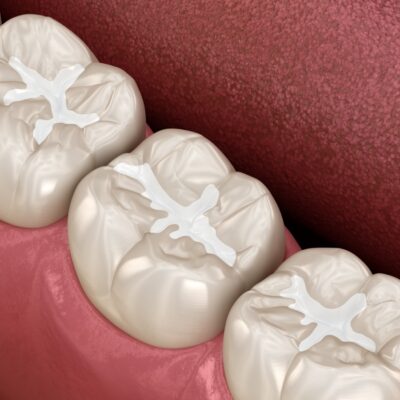When your tooth has a cavity or needs to be repaired due to wear or chipping, we use a few different dental filling materials depending on what is appropriate for the condition of your tooth. When determining which material is right for you to achieve the best long-term result we consider several factors including:
- The amount of natural tooth structure present
- The extent of the decay or chip
- The location in the mouth for load and esthetic demands
- The patient’s concerns for time, appearance, and cost
Before we perform any treatment, we allow adequate time for a discussion on what your options are, and what we recommend for your particular situation.
Tooth Colored Fillings
For smaller cavities or repairs we use a tooth colored composite resin material that comes in various shades to achieve a custom match of your natural tooth structure. Due to our ability to durably bond this material to your tooth, it allows us to retain or keep as much of your natural tooth as possible. Other filling materials such as a silver filling may require larger increments which can result in sacrificing more of your healthy tooth structure. We can also achieve very natural results with composite resin when placing a composite veneer or when repairing front teeth.
What About Silver Fillings?
While there are some distinct advantages and disadvantages of silver (or amalgam) fillings, we do not place this material at Downtown Dental. Silver fillings can prove to be a very long lasting restoration for many people. For others, they feel the silver is unsightly or unhealthy and request for their removal. If you have questions or concerns about silver fillings in your mouth we would be glad to access the condition of them and address your concerns.
The Procedure
The first step is often placement of topical anesthetic gel before the administration of local anesthetic in the area. This ensures you are completely comfortable and numb before proceeding with the restoration. A barrier or dental dam is often placed around the tooth to help assist in removal of debris and to help keep the area dry for the best bond to the tooth. The next step is removal of the decayed area in preparation for bonding filling material to solid, healthy tooth structure. The filling material is then placed, shaped and bonded securely into place using a special curing light.
What about Ceramic Fillings?
When there is too much damage to support a small filling but not enough for the tooth to need a full crown we may recommend a more durable ceramic filling. These restorations are referred to as inlays or onlays. The procedure for the patient is similar to that of a simple filling except we design the filling on the computer after taking a digital photo or impression. Once the restoration has been designed and milled in the office, we then bond the restoration into the prepared cavity and adjust it as needed.
There are a lot of factors to consider when we assess your teeth. Some conditions may have more immediate consequences if not addressed. Early signs of decay, however, may have the chance to not progress or even remineralize without the need for a dental restoration. We feel it’s our job to inform you of the condition of your mouth and help walk you through what restorative options would have the best outcomes for the long-term health and stability of our mouth. Call us today if you have questions about filling materials or if you’re ready to get an assessment of the condition of your teeth.


